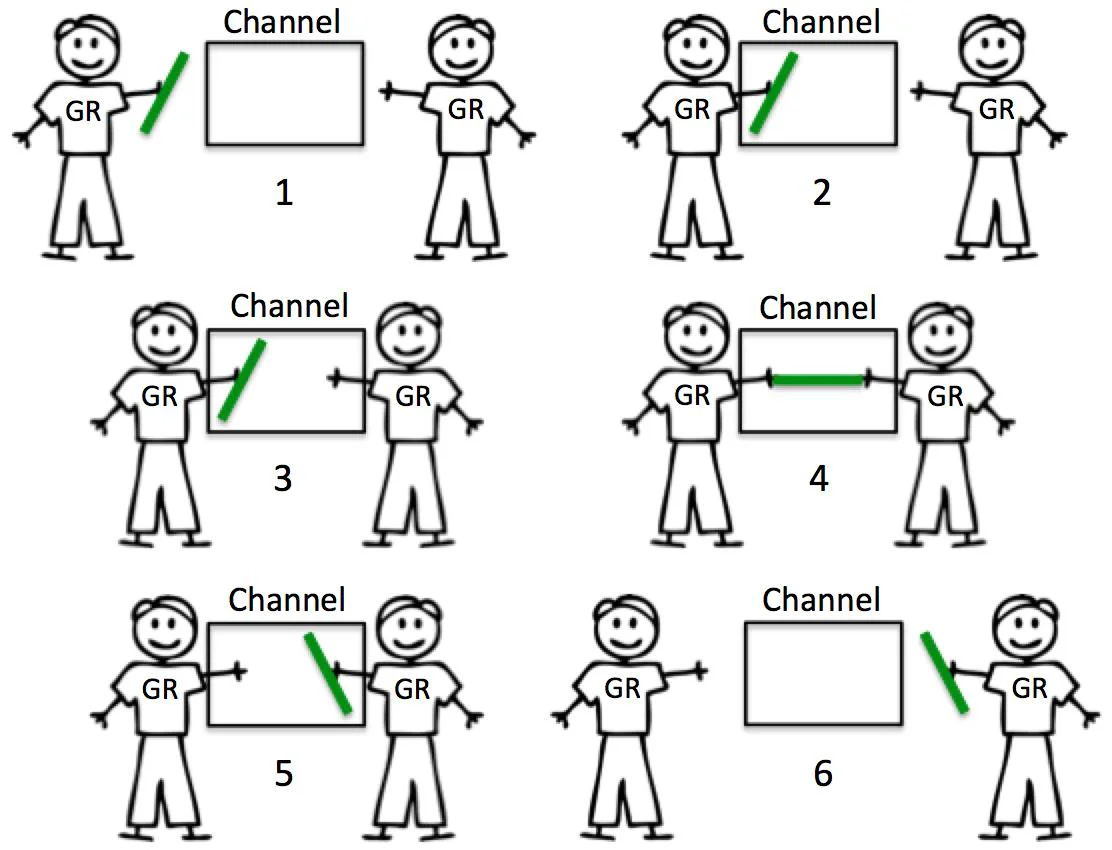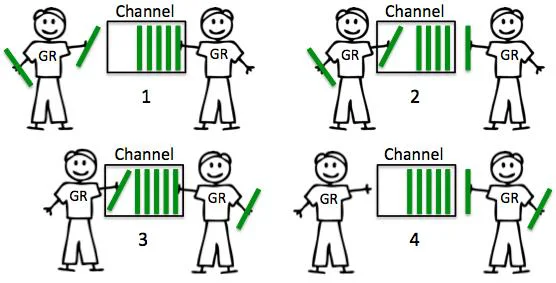Posted YuNansen
tags: .深入理解c指针 .net静态对象的深入理解
篇首语:本文由小常识网(cha138.com)小编为大家整理,主要介绍了深入理解Golang之channel相关的知识,希望对你有一定的参考价值。
前言
Golang在并发编程上有两大利器,分别是channel和goroutine,这篇文章我们先聊聊channel。熟悉Golang的人都知道一句名言:“使用通信来共享内存,而不是通过共享内存来通信”。这句话有两层意思,Go语言确实在sync包中提供了传统的锁机制,但更推荐使用channel来解决并发问题。这篇文章会先从channel的用法、channel的原理两部分对channel做一个较为深入的探究。
channel用法
什么是channel
从字面上看,channel的意思大概就是管道的意思。channel是一种go协程用以接收或发送消息的安全的消息队列,channel就像两个go协程之间的导管,来实现各种资源的同步。可以用下图示意:

channel的用法很简单:
func main()
ch := make(chan int, 1) // 创建一个类型为int,缓冲区大小为1的channel
ch <- 2 // 将2发送到ch
n, ok := <- ch // n接收从ch发出的值
if ok
fmt.Println(n) // 2
close(ch) // 关闭channel
使用channel时有几个注意点:
- 向一个nil channel发送消息,会一直阻塞;
- 向一个已经关闭的channel发送消息,会引发运行时恐慌(panic);
- channel关闭后不可以继续向channel发送消息,但可以继续从channel接收消息;
- 当channel关闭并且缓冲区为空时,继续从从channel接收消息会得到一个对应类型的零值。
Unbuffered channels与Buffered channels
Unbuffered channels是指缓冲区大小为0的channel,这种channel的接收者会阻塞直至接收到消息,发送者会阻塞直至接收者接收到消息,这种机制可以用于两个goroutine进行状态同步;Buffered channels拥有缓冲区,发送者在将消息发送到缓冲区之前是阻塞的,当缓冲区已满时,发送者会阻塞;当缓冲区为空时,接收者会阻塞。
引用The Nature Of Channels In Go中的两张图来说明Unbuffered channels与Buffered channels, 非常形象,读者可自行体会一下:
Unbuffered channels:

Buffered channels:

channel的遍历
for range
channel支持 for range 的方式进行遍历:
package main
import "fmt"
func main()
ci := make(chan int, 5)
for i := 1; i <= 5; i++
ci <- i
close(ci)
for i := range ci
fmt.Println(i)
值得注意的是,在遍历时,如果channel 没有关闭,那么会一直等待下去,出现 deadlock 的错误;如果在遍历时channel已经关闭,那么在遍历完数据后自动退出遍历。也就是说,for range 的遍历方式时阻塞型的遍历方式。
for select
select可以处理非阻塞式消息发送、接收及多路选择。
package main
import "fmt"
func main()
ci := make(chan int, 2)
for i := 1; i <= 2; i++
ci <- i
close(ci)
cs := make(chan string, 2)
cs <- "hi"
cs <- "golang"
close(cs)
ciClosed, csClosed := false, false
for
if ciClosed && csClosed
return
select
case i, ok := <-ci:
if ok
fmt.Println(i)
else
ciClosed = true
fmt.Println("ci closed")
case s, ok := <-cs:
if ok
fmt.Println(s)
else
csClosed = true
fmt.Println("cs closed")
default:
fmt.Println("waiting...")
select中有case代码块,用于channel发送或接收消息,任意一个case代码块准备好时,执行其对应内容;多个case代码块准备好时,随机选择一个case代码块并执行;所有case代码块都没有准备好,则等待;还可以有一个default代码块,所有case代码块都没有准备好时执行default代码块。
channel原理
先贴一下channel的源码地址,读者可以对照来看。
数据结构
先看channel的结构体:
type hchan struct
qcount uint // total data in the queue
dataqsiz uint // size of the circular queue
buf unsafe.Pointer // points to an array of dataqsiz elements // channel中元素大小
elemsize uint16 // 是否已关闭
closed uint32 // channel中元素类型
elemtype *_type // element type
sendx uint // send index
recvx uint // receive index
recvq waitq // list of recv waiters
sendq waitq // list of send waiters
// lock protects all fields in hchan, as well as several
// fields in sudogs blocked on this channel.
//
// Do not change another G's status while holding this lock
// (in particular, do not ready a G), as this can deadlock
// with stack shrinking.
lock mutex
channel的缓冲区其实是一个环形队列,qcount表示队列中元素的数量,dataqsiz表示环形队列的总大小,buf表示一个指向循环数组的指针;sendx和recvx分别用来标识当前发送和接收的元素在循环队列中的位置;recvq和sendq都是一个列表,分别用于存储当前处于等待接收和等待发送的Goroutine。
再看一下waitq的数据结构:
type waitq struct
first *sudog
last *sudog
type sudog struct
// 当前goroutine
g *g
// isSelect indicates g is participating in a select, so
// g.selectDone must be CAS'd to win the wake-up race.
isSelect bool
next *sudog
prev *sudog
elem unsafe.Pointer // data element (may point to stack)
// The following fields are never accessed concurrently.
// For channels, waitlink is only accessed by g.
// For semaphores, all fields (including the ones above)
// are only accessed when holding a semaRoot lock.
acquiretime int64
releasetime int64
ticket uint32
parent *sudog // semaRoot binary tree
waitlink *sudog // g.waiting list or semaRoot
waittail *sudog // semaRoot
c *hchan // channel
其中sudog表示处于等待列表中的Goroutine封装,包含了一些上下文信息,first和last分别指向等待列表的首位的Goroutine。
编译分析
在分析channel的原理之前,我们先使用go tool分析以下代码,看看channel的各种操作在底层调用了什么运行时方法:
ch := make(chan int, 2)
ch <- 2
ch <- 1
<-ch
n, ok := <-ch
if ok
fmt.Println(n)
close(ch)
编译
go build test.go
go tool objdump -s "main\\.main" test | grep CALL
把CALL过滤出来:
test.go:118 0x1092f55 e81612f7ff CALL runtime.makechan(SB) test.go:119 0x1092f74 e82714f7ff CALL runtime.chansend1(SB) test.go:120 0x1092f8e e80d14f7ff CALL runtime.chansend1(SB) test.go:121 0x1092fa5 e8361ff7ff CALL runtime.chanrecv1(SB) test.go:122 0x1092fbd e85e1ff7ff CALL runtime.chanrecv2(SB) test.go:126 0x1092fd7 e8841cf7ff CALL runtime.closechan(SB) test.go:124 0x1092fea e8b156f7ff CALL runtime.convT64(SB) print.go:275 0x1093041 e88a98ffff CALL fmt.Fprintln(SB) test.go:47 0x1093055 e896c1fbff CALL runtime.morestack_noctxt(SB)
创建
从上面的编译分析可以看出在创建channel时调用了运行时方法makechan:
func makechan(t *chantype, size int) *hchan elem := t.elem // compiler checks this but be safe. if elem.size >= 1<<16 throw("makechan: invalid channel element type") if hchanSize%maxAlign != 0 || elem.align > maxAlign throw("makechan: bad alignment") // 计算缓冲区需要的总大小(缓冲区大小*元素大小),并判断是否超出最大可分配范围 mem, overflow := math.MulUintptr(elem.size, uintptr(size)) if overflow || mem > maxAlloc-hchanSize || size < 0 panic(plainError("makechan: size out of range")) // Hchan does not contain pointers interesting for GC when elements stored in buf do not contain pointers. // buf points into the same allocation, elemtype is persistent. // SudoG's are referenced from their owning thread so they can't be collected. // TODO(dvyukov,rlh): Rethink when collector can move allocated objects. var c *hchan switch case mem == 0: // 缓冲区大小为0,或者channel中元素大小为0(struct)时,只需分配channel必需的空间即可 // Queue or element size is zero. c = (*hchan)(mallocgc(hchanSize, nil, true)) // Race detector uses this location for synchronization. c.buf = c.raceaddr() case elem.kind&kindNoPointers != 0: // 通过位运算知道channel中元素类型不是指针,分配一片连续内存空间,所需空间等于 缓冲区数组空间 + hchan必需的空间。 // Elements do not contain pointers. // Allocate hchan and buf in one call. c = (*hchan)(mallocgc(hchanSize+mem, nil, true)) c.buf = add(unsafe.Pointer(c), hchanSize) default: // 元素中包含指针,为hchan和缓冲区分别分配空间 // Elements contain pointers. c = new(hchan) c.buf = mallocgc(mem, elem, true) c.elemsize = uint16(elem.size) c.elemtype = elem c.dataqsiz = uint(size) if debugChan print("makechan: chan=", c, "; elemsize=", elem.size, "; elemalg=", elem.alg, "; dataqsiz=", size, "\\n") return c
makechan的代码逻辑还是比较简单的,首先校验元素类型和缓冲区空间大小,然后创建hchan,分配所需空间。这里有三种情况:当缓冲区大小为0,或者channel中元素大小为0时,只需分配channel必需的空间即可;当channel元素类型不是指针时,则只需要为hchan和缓冲区分配一片连续内存空间,空间大小为缓冲区数组空间加上hchan必需的空间;默认情况,缓冲区包含指针,则需要为hchan和缓冲区分别分配内存。最后更新hchan的其他字段,包括elemsize,elemtype,dataqsiz。
发送
未完待续
转自:https://juejin.im/post/5decff136fb9a016544bce67
以上是关于深入理解Golang之channel的主要内容,如果未能解决你的问题,请参考以下文章
